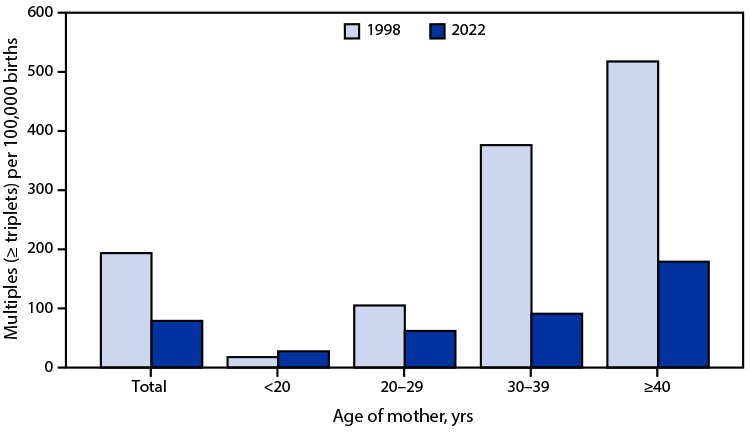Category: multiple births
QuickStats: Rate of Triplet and Higher-Order Multiple Births by Age of Mother — National Vital Statistics System, United States, 1998 and 2022

The triplet and higher-order multiple birth rate declined from an all-time high of 193.5 per 100,000 total births in 1998 to 78.9 in 2022. From 1998 to 2022, triplet and higher-order birth rates increased among mothers aged <20 years (from 17.6 to 27.5) but declined among mothers aged ≥20 years. In both 1998 and 2022, Read More >
Posted on byBirths: Final Data for 2018
Questions for Joyce Martin, Health Statistician and Lead Author of “Births: Final Data for 2018” Q: What is new in this report from the 2018 provisional birth report? JM: In addition to providing final numbers and rates for numerous birth characteristics such as fertility rates, teen childbearing, cesarean delivery and preterm and low birthweight, this Read More >
Posted on byFact or Fiction: Are multiple births in the U.S. are on the decline?
http://www.youtube.com/watch?v=2R4PNatqV54 Source: National Vital Statistics System Data Brief 351. Is Twin Childbearing on the Decline? Twin Births in the United States, 2014–2018 Read More >
Posted on byIs Twin Childbearing on the Decline? Twin births in the United States, 2014-2018
Questions for Joyce Martin, Lead Author of, “Is Twin Childbearing on the Decline? Twin births in the United States, 2014-2018.” Q: Is this the first time you have published a report on this topic? JM: General information on twin births is published annually in the National Vital Statistics Report series “Births: Final Data.” A number Read More >
Posted on byBirths: Final Data for 2015
Questions for Joyce A. Martin, M.P.H., Demographer, Statistician, and Lead Author on “Births: Final Data for 2015” Q: Was there a result in your study’s analysis of births in the United States that you hadn’t expected and that really surprised you? JM: Although small, (from 9.57% to 9.63%) the rise in the preterm birth rate Read More >
Posted on byDeclines in Triplet and Higher-order Multiple Births in the United States, 1998–2014
The incidence of triplet and higher-order multiple births rose fourfold during the 1980s and 1990s. This rise was associated with older maternal age and the increased use of fertility-enhancing therapies and was of concern because of the greater risk of adverse outcome of triplet and higher-order births compared with singletons and the added toll of Read More >
Posted on byBirths–Using the NCHS Vital Stats Tool
NCHS birth tables with a variety of variables for selection are available at http://www.cdc.gov/nchs/datawh/vitalstats/VitalStatsbirths.htm. By selecting the national or subnational (i.e., state and some county) levels, you can find specific statistics for national, state, and some county birth rates, fertility rates, method of delivery (vaginal or cesarean), length of pregnancy, birthweight, characteristics of the mother Read More >
Posted on byTeen births increase in over one-half of states
The teen birth rate increased in more than half of all 50 states in 2006, according to an NCHS report released today. Click here for the report. The data show teen birth rates were highest in the South and Southwest, with the highest rate recorded in Mississippi (68.4), followed by New Mexico (64.1) and Texas Read More >
Posted on byMultiple Births
The twin birth rate rose 2 percent for 2004, to 32.2 twins per 1,000 total births, another record high. The twinning rate has climbed 42 percent since 1990 (from 22.6), and 70 percent since 1980 (18.9). The number of live births in twin deliveries rose to 132,219, nearly double the number reported for 1980 (from Read More >
Posted on by
